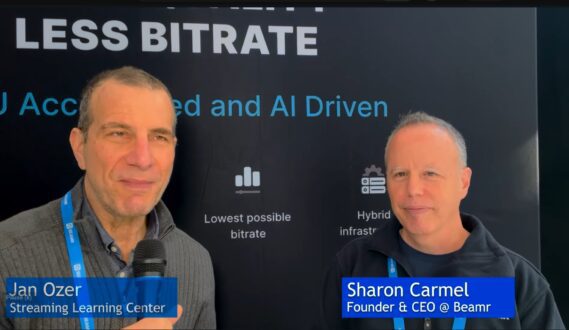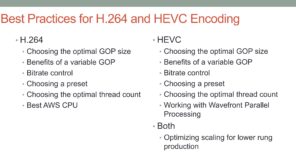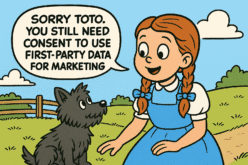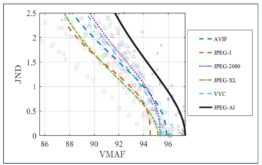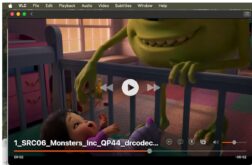Jan Ozer recently caught up with Beamr’s Sharon Carmel at Mile High Video 2025. The two talked about Beamr’s latest advancements in real-time content-adaptive bitrate (CABR) optimization, super-resolution technology, and codec modernization. They also discussed Beamr’s collaboration with NVIDIA and how AI is shaping the future of video streaming. You can watch the interview on YouTube here, and it’s embedded below.
Quotes have been lightly edited for conciseness and readability.
What Beamr Presented at Mile High Video
Ozer started the conversation by asking Sharon what Beamr was presenting at Mile High Video 2025. Sharon replied, “This year, we came here with a solution for super-resolution on NVIDIA GPUs. We took all of our content adaptive technology to GPUs, and it now works in real-time 4K P60. We have live optimization solutions that bring about 40% bitrate efficiency to video encoding using Nvenc on NVIDIA GPUs.”
He explained further, “These same GPUs can run AI algorithms, so why not use the available GPU to run other tasks, like super-resolution? What we’re demonstrating here today is how we optimize video in real-time while also running super-resolution processes that increase the video resolution by four times. This means we can take 720p or 480p videos and bring them up to 1080p and 4K.”
Sharon clarified the current capabilities: “That’s real-time with transcoding at the back end. The demo here wasn’t real-time, but that’s what we aim for.”

Real-Time CABR with NVIDIA GPUs
Sharon started discussing the different technologies Beamr presented at the show, starting with its well-known Content-Adaptive Bitrate technology (CABR). CABR is a quality-based rate control method that measures the visual quality of each frame during video encoding. If the frame quality is sufficient, the bitrate is kept steady; if there is room for optimization, the bitrate is reduced—ensuring consistent quality without unnecessary data usage.
The big news was Beamr’s relationship with NVIDIA. As Sharon explained, “The development that we’ve done with NVIDIA is creating APIs that help us control the NVIDIA GPU to bring our content adaptive quality measure to the platform. For that, we needed very fine control of Nvenc. So, we defined those APIs together with NVIDIA, and they implemented everything on their end, ensuring the driver supports it. As of Media SDK 12.1 and onwards, these APIs are supported.”
He continued, “On our end, we needed to take all our technology from CPU to GPU, which was a complete rewrite because it needs to run in parallel and very efficiently. It was heavy lifting, definitely on NVIDIA’s side and also on the Beamr end, bringing this technology in.”
This collaboration allows Beamr to achieve real-time 4K60 CABR optimization with about 40% bitrate efficiency using Nvenc on NVIDIA GPUs. The fine-grained control APIs enable precise quality measurements per frame, ensuring bitrate savings without sacrificing visual quality.
Super Resolution Technology: Current Capabilities and Future Goals
In addition to CABR, Sharon discussed Beamr’s advancements in super-resolution technology. Super-resolution uses AI algorithms to increase the resolution of lower-quality videos, effectively scaling 720p or 480p content up to 1080p or even 4K. Sharon explained several applications for super-resolution, noting, “You can take old video archives shot in standard definition and turn them into 4K. It was a very costly, labor-intensive post-processing task, but now it’s done automatically.” He added, “We’ve run about twenty models, and the results are pretty good. I’d say they’re 98-99% of what we’d like to see as a result.”
Another application is enhancing lower-resolution user-generated content, such as 480p or 720p videos, to meet modern viewing standards. This is particularly useful for content libraries that need to be upgraded to HD or 4K quality without reshooting or expensive post-production.
Regarding the NVIDIA tie, Sharon observed, “These same GPUs that drive CABR can run AI algorithms, so why not use the available GPU to run other tasks, like super-resolution? What we’re demonstrating here today is how we optimize video in real-time while also running super-resolution processes that increase the video resolution by four times. This means we can take 720p or 480p videos and bring them up to 1080p and 4K.”
However, Sharon was clear about the current limitations: “To be frank, the demo here wasn’t real time, but that’s what we’re aiming for.” Although the super-resolution technology is not yet operating in real-time, Beamr’s goal is to achieve this in future iterations.
Jan asked about how AI-based super-resolution compared to traditional TV scalers, which rely on linear interpolation to upscale video. In contrast, Beamr’s super resolution uses AI to “invent” new image details by analyzing and enhancing key visual features. Sharon noted, “When you’re creating enormous scaling, like 4x on each dimension, it’s very hard to do with linear scalers. You need to learn what’s important—what are the key edges and details—and to enhance that. This is not what the television scalers are doing today. For that, you need different logic, and this is the super resolution we’re discussing now.”
This not only improves video resolution but also significantly enhances the perceived image quality, setting Beamr’s technology apart from conventional solutions.
Codec Modernization and Market Trends
Sharon also discussed how Beamr’s solutions help companies transition from AVC to more advanced codecs like HEVC and AV1 with enhanced efficiency. By leveraging NVIDIA GPUs and content-adaptive bitrate control, Beamr enables significant bitrate savings while maintaining high visual quality.
According to Sharon, “What you can do is not just achieve better efficiency—like making HEVC or AV1 encodes 30 to 40% more efficient—but also modernize older codecs. For example, you can take AVC content and convert it to HEVC or AV1. This way, you get a double effect: you benefit from the advanced mathematics of the newer codec and from CABR in parallel.”
Sharon emphasized that Beamr’s technology ensures a smooth transition by maintaining consistent quality on a per-frame basis: “Using our quality measure, we make sure that per frame, the process of moving from AVC to HEVC gives you probably 40% or even more bitrate savings, depending on your recipes, and it will be perfect per frame.”
Discussing market adoption trends, Sharon noted that HEVC remains the dominant choice among Beamr’s customers, especially for premium content. However, AV1 is gaining traction in specific areas, particularly in user-generated content and second screen viewing. He explained, “When it comes to AV1, there is a lot of demand, especially around user-generated content and second screen viewing. We were happy to have a solution with NVIDIA because we now have a great AV1 solution that’s very fast and adds about 40% bitrate efficiency.”
Sharon also touched on the outlook for VVC, the next-generation video codec. “Being in this industry for many years, I can tell you that Beamr has no plans to create its own VVC encoder, just as we didn’t for AV1. These things take time. From introduction to market traction, it’s usually about ten years.” He added that widespread adoption depends on hardware support and industry alignment, noting, “There’s always a transitional process where content distributors wait to see enough decoder availability before adopting yet another standard.”
By supporting HEVC, AV1, and the potential future adoption of VVC, Beamr is positioning itself as a leader in codec modernization, helping content providers optimize video quality and efficiency across all major platforms.
Industry Insights and the Role of Mile High Video
Sharon also spoke about the significance of attending Mile High Video and its impact on Beamr’s industry engagement. He emphasized the importance of networking and knowledge sharing with top specialists in the video streaming and encoding space.
“For us at Beamr, it’s a learning experience,” Sharon explained. “We want to understand what’s new, what the challenges are, and where it hurts when it comes to content distribution and encoding. Mile High Video is the place where industry experts come together, and it gives us the opportunity to have serious conversations with our peers.”
Sharon highlighted the unique value of Mile High Video’s smaller, more focused environment. “It’s not too big, so you have time to engage in meaningful discussions. That’s a wonderful experience,” he noted. This setting allows Beamr to stay at the forefront of industry trends while also contributing to the broader conversation about the future of video encoding and streaming technology.
By actively participating in events like Mile High Video, Beamr continues to engage with industry leaders, gather valuable insights, and showcase its innovations in real-time CABR, super-resolution, and codec modernization.
For more detailed insights into Beamr’s innovations in real-time CABR, super-resolution, and codec modernization, be sure to watch the full interview. Sharon Carmel shares in-depth explanations about Beamr’s collaboration with NVIDIA, the future of video streaming, and the role of AI in video encoding.
To learn more about Beamr and its advanced video solutions, visit their website at www.beamr.com.
For additional information on CABR, check out these resources:
- NVIDIA Live 4Kp60 Optimized Encoding with Beamr CABR and NVIDIA Holoscan for Media – Read more at https://blog.beamr.com/2024/09/10/live-4kp60-optimized-encoding-with-beamr-cabr-and-nvidia-holoscan-for-media/.
- Overview of CABR Technology – Learn more at https://beamr.com/cabr#cabr-header.
 Streaming Learning Center Where Streaming Professionals Learn to Excel
Streaming Learning Center Where Streaming Professionals Learn to Excel

